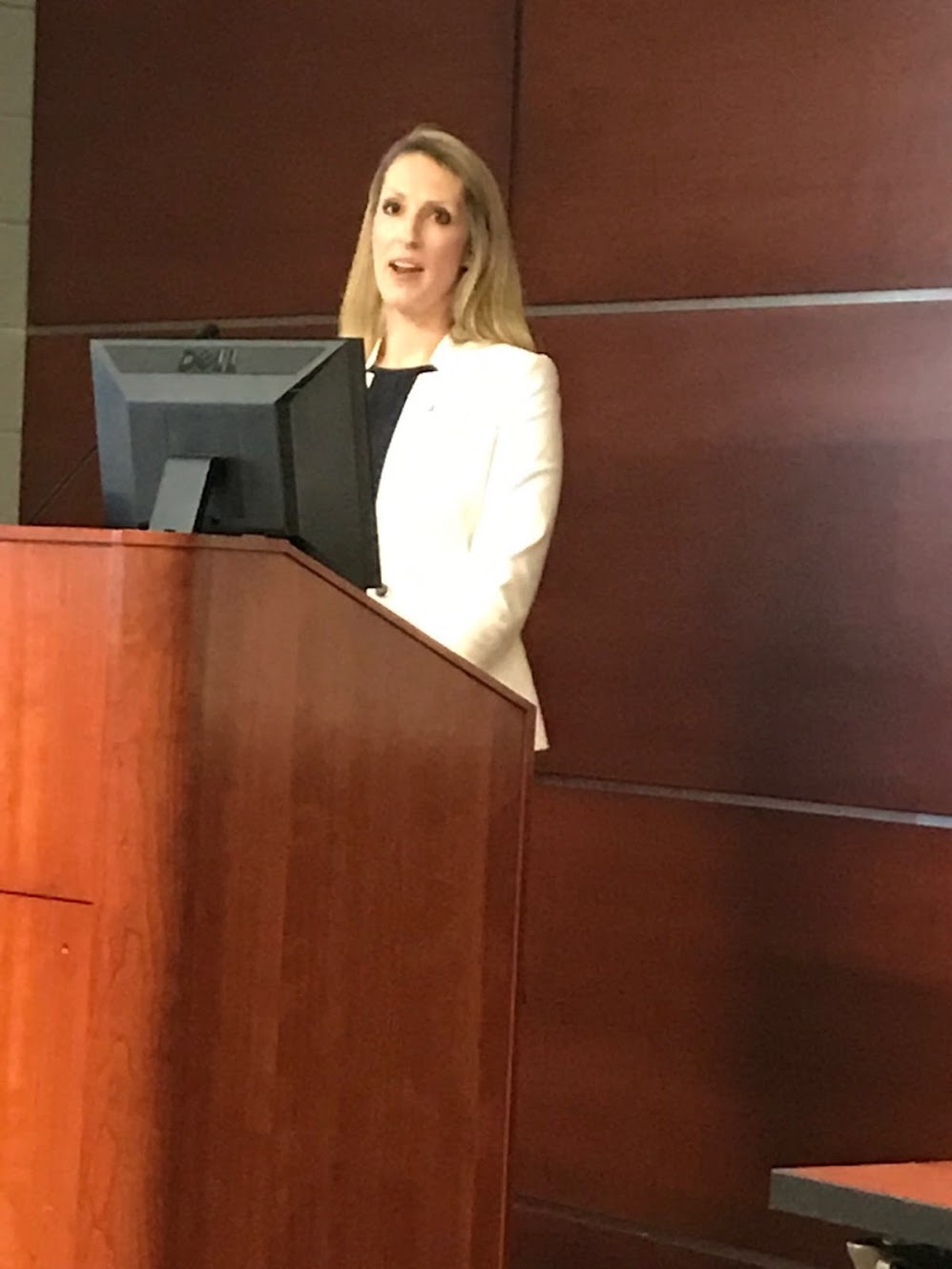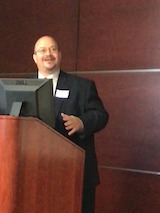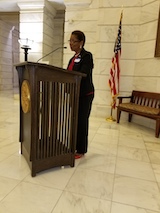Economic Equality Caucus
which advocates for economic equality across the USA.
| Home | Organizational Structure | State Coordinators | Executive Director | Caucus Articles | Memberships | |||||
| "Delta Vision, Delta Voices" | ||||||||||
|
Help Advocate for Economic Progress and Equality. Donate to the Delta Caucus/Economic Equality Caucus. |
||||||||||
Delta Grassroots Caucus Events

Credit Michael Hibblen/ KUAR News, Arkansas Public Radio; Former President Bill Clinton speaking to the Delta Grassroots Caucus on May 2, 2013, at the University of Arkansas Clinton School of Public Service, Little Rock

U. S. Senator John Boozman, Arkansas, at a Delta Grassroots Caucus meeting at the US Capitol

Brad Cole, Executive Director of the Municipal League of Illinois; previously a senior aide to former Republican US Sen. Mark Kirk of Illinois, earlier Mayor of Carbondale, Illinois, veteran Delta regional advocate, speaking at the Delta regional conference in West Memphis, Arkansas on April 26, 2019.

President Bill Clinton makes a comment to Delta Caucus Director Lee Powell at a meeting in Blytheville, Arkansas (in the northeast Arkansas Delta) on Nov. 2, 2014

The Delta Caucus would like to pay tribute to the late, great U.S. Sen. Thad Cochran of Mississippi, a powerful force in the US Senate for decades and a champion for the Delta. Sen. Cochran passed away on May 30, 2019. He spoke to the Delta Caucus on many occasions over the years (he is pictured above speaking to a Caucus event on Capitol Hill in Washington, DC) and his thoughtful, courteous and bipartisan leadership will be sorely missed.

Marcie Lawson, Executive Director, Sikeston, Missouri Regional Chamber and Area Economic Development Corporation, speaking at the Delta regional conference in West Memphis, Arkansas on April 26, 2019.

Alan Gumbel, Greater Memphis Alliance for a Competitive Workforce, Memphis, Tennessee, speaking at the Delta regional conference in West Memphis, Arkansas on April 26, 2019.

Mayor Shirley Washington of Pine Bluff, AR, speaking to the Delta Caucus at the Arkansas Capitol Rotunda in 2017.
The Dutch and Mississippi Deltas' Experiences with Flooding Issues
Posted on July 29, 2011 at 09:14 AM
We would like to focus on similarities between the Dutch and Mississippi River Delta experiences with flood control, and below we will convey an article written by the Dutch Ambassador to the USA, Renee Jones-Bos. There are differences between the Dutch Delta and the Mississippi Delta, but there is also a basic similarity in that both regions generate massive economic productivity and two great cultures, yet continue to flourish despite the frequent threat of flooding.
Flooding issues will be an important subject at our Nov. 1-3 conference in Washington, DC.
The Dutch government is currently doing flood control projects in New Orleans, so this is not just an academic exercise.
We have some comments and one respectful disagreement with the Dutch Ambassador’s position, and then we will reprint the entire article below and you can draw your own conclusions.
The Dutch thrive despite severe flooding threats: The Rhine-Maas Delta in many areas is even lower than the Mississippi Delta. Consider these facts: 60% of the entire country of the Netherlands is at or below sea level; two thirds of the Dutch people live in flood-prone areas; 70% of Dutch gross domestic product is produced under threat of water; and while the Dutch job-producing harbors and their wetlands’ biodiversity provide wealth in so many different meanings of that term, the floods can cause billions of dollars in damage, and floods in 1993 and 1995 forced the evacuation of over 250,000 people.
Double standard in attitudes toward The Netherlands and the Mississippi Delta: I have lived in New Orleans, the First District in east Arkansas, and Memphis, all places occasionally threatened by flooding. That is why it is so amazing to hear intelligent, well-meaning but ill-informed people outside the Delta patronizingly talk about how ignorant people in the Mississippi Delta are to live there. At the time of Hurricane Katrina I listened to wealthy, well-educated people from the Washington, DC area who had come down with me to volunteer after the disaster who condescendingly talked about how “Of course, there really should not be a city where New Orleans is located, because it is so vulnerable to flooding and storms.” They had no idea how ignorant and arrogant those comments sounded to someone who had lived there.
On the argument that people should not live in water-threatened areas from southeast Missouri and southern Illinois down to New Orleans, then there should not be a nation where The Netherlands is located. This is preposterous. The Mississippi levee system needs improvements and repairs, but it fundamentally held and protected the vast majority of the people of our region in this year’s massive flooding.
There is a double standard here: the rich, predominantly white nation of The Netherlands wins accolades as brilliant engineers for their flood protection system in a land both with a coastline on the sea and drained by two large river systems.
In contrast, the Mississippi Delta is an economically distressed area with a southern area facing the Gulf and its storms, and with a diverse population of whites, African Americans, a growing Hispanic population, and areas with significant Asian American groups. This diverse, economically distressed area is often viewed very differently from the wealthy European nation of The Netherlands. We are too often regarded in this patronizing and ignorant attitude by many people in our country outside the region who ask the nonsensical question, “Why are those people foolish enough to live so close to the ferocious Mississippi River?”
We applaud Ambassador Jones-Bos’ clear sympathy for the Mississippi Delta, and for her stand that a civilization can and must be built near massive river systems. She is also correect that climate change is producing wetter winters, higher river crests, and thus the problem will gradually get more serious as time proceeds and we need to be prepared for these changes and develop responses to them.
There is one obvious difference between our experiences: large as the Rhine-Maas system is, the Mississippi River system is much larger and the volume of water is far greater.
Not all of our partners will agree with all of her assessments. Creating river diversions, temporary water storage areas, using cisterns, green roofs and other methods of retaining the water where it falls, developing natural water storage sponges, are all policies that should be considered and put into action where the funding and other realities permit. We certainly agree with a need to protect biodiversity, and the economic impact of ecotourism is very promising for our region.
There is always the issue that in some cases, some areas will have to be flooded to preserve other larger areas. This happened in the flooding this year, especially in Missouri and Louisiana. However, we have to be careful about the argument of letting the flood plain expand “as the river wishes,” because that argument carried too far takes us back to where we were in 1927 when much of the Delta became a vast lake and countless lives and wealth were destroyed.
The one point where many of us would definitely disagree with the Ambassador is where she described Major General Edgar Jadwin, head of the Army Corps of Engineers at the time of the 1927 flood as “prescient.” The Ambassador may not be aware of the relevant history here: Jadwin worked with President Calvin Coolidge immediately after the massive 1927 flood to propose the least expensive flood control proposal possible, and Coolidge of course liked it because it was cheap. The problem was that the “Jadwin plan” was hopelessly inadequate as far as developing an adequate flood control system.
Under pressure from more thoughtful leaders, a more reasonable bill was developed, and Coolidge was pressured into signing it. There was hyperbole by some of its supporters, such as Illinois Congressman Frank Reid, who called it “perhaps the greatest engineering feat the world has ever known…It is the greatest piece of legislation ever enacted by Congress.”
A more measured view is given by John Barry in his book, Rising Tide: The Great Mississippi Flood of 1927 and How It Changed America. Mr. Barry worked with us at the Delta conference in 2000 and wrote an article for the Delta Vision, Delta Voices report that the Clinton administration published that year. Barry said the law had many flaws such as insufficient compensation for use of private lands, some engineering weaknesses along with the positive accomplishments, and inadequate funding.
The legislation’s supporters knew of its flaws but in the face of the Coolidge-Jadwin original position they believed it was better to pass the version that was at least significantly improved over Jadwin, and indeed there were continuous revisions over the next 10 years. It was a national problem and required a national solution.
As Barry wrote, “More important, the law declared that the federal government took full responsibility for the Mississippi River. ‘In so doing, even in the narrowest sense, the law set a precedent of direct, comprehensive and vastly expanded federal involvement in local affairs. In the broadest sense, this precedent reflected a major shift in what Americans considered the proper role and obligation of the national government, a shift that both presaged and prepared the way for far greater changes that would soon come.” The latter is a reference to the New Deal a few years later.
We would respectfully disagree with the description of Jadwin as “prescient;” with “bureaucratic, unimaginative and hard-hearted” being more accurate descriptions of the man who wanted to save money on flood control after one of the worst disasters in American history.
Nonetheless, most of the comments in the Dutch Ambassador’s article are thoughtful and we commend her sympathy for the Mississippi Delta’s determination to thrive beside the Mighty Mississippi. Lee Powell, MDGC (202) 360-6347
“As the Mississippi floods, follow the Dutch model”
By Renée Jones-Bos, Published: May 26, 2011, Washington Post
Nature can be a ruthless teacher. Whether you live along the Mississippi River or in the Dutch delta, water is at once your best friend and your worst enemy.
When snow falls in Montana, or rain in western New York, it cascades through America’s heartland and along the Mississippi River system that drains two-fifths of the U.S. landmass. Similarly, a snowflake falling in Switzerland or a raindrop falling in northern France follows a familiar course to the Netherlands. The Mississippi River deltaic plain and the Rhine-Maas delta are the river systems’ valves.
These are wonderful, and dangerous, places to live, with job-producing harbors and wetlands’ unique biodiversity. But they also carry the risk of destructive floods that can cause tens of billions of dollars in damage.
Sixty percent of the Netherlands is at or below sea level; two-thirds of its people live in flood-prone areas; and 70 percent of Dutch gross domestic product is produced in areas under threat of water. The cadence of Dutch history is marked by floods and the response to them.
For me, as ambassador of the Netherlands, this year’s Mississippi flooding is a reminder of 1993 and 1995, when our rivers swelled to unprecedented levels. Large tracts of farmland were inundated; 250,000 people were evacuated. Direct flood damages exceeded $300 million, or 0.5 percent of Dutch GDP.
Our pat response to previous floods was much like those in the United States: Build the dikes higher, constrain the rivers more tightly, master the landscape. But something changed in the Netherlands in the late 1990s. More homes and businesses than ever had been built directly “behind the dikes,” in subsiding land. Climate change began to produce wetter winters, leading to repeated, dangerous river crests. Combined with the old Dutch adage that “there are two types of levees: those that have failed, and those that will,” those factors made us realize that something else needed to change.
Room for the River was born.
This project, implementation of which started in 2006, restores the river’s natural flood plain in places where it is least harmful in order to protect those areas that need to be defended. By 2015, through a series of 35 projects costing $3 billion, we will have lowered and broadened our flood plain and created river diversions and temporary water storage areas. We will restore marshy riverine landscapes to serve once again as natural “water storage” sponges and provide biodiversity and aesthetic and recreational values.
Complementing Room for the River are two corollary policies: “Retain, Store, Drain” and “Living With Water.” They encourage neighborhoods to retain water where it falls, using cisterns, green roofs and floodable parks. Living With Water demands that urban planners and water managers create communities wherein water is a cherished asset and not something to fear and keep out of sight.
These efforts have not come without controversy. The Netherlands is the world’s third-most-densely populated country. Intensive land use is common. Forgoing hard-won reclaimed land is politically difficult. But the disastrous floods of the ’90s provided fertile political ground to start a process involving all stakeholders: citizens, businesses and local governments. The 35 Room for the River projects were developed with the input of all of them.
The Mississippi River and its tributaries form a river basin much larger and more powerful than the rivers coursing through the Netherlands. Land-use patterns in the Mississippi basin are far more diverse. But after the disastrous floods of 1927, the prescient Maj. Gen. Edgar Jadwin of the Army Corps of Engineers said: “Make room for the river.” His call was echoed after the 1993 floods.
We believe that Room for the River has brought us safety and increased resiliency to climate change. We have a stronger ecosystem and more community amenity. We have fewer costs in upfront expenditures and post-disaster repairs. We know what it feels like to see homes and livelihoods swept away by the flow of unyielding water. That’s why since Hurricane Katrina, we have worked closely with those living in and managing the Mississippi Delta. Our sympathy goes out to the people there. And again, we stand ready to share our experience with those blessed and cursed by the mighty Mississippi.
The writer is the Netherlands’ ambassador to the United States.
Back to the top